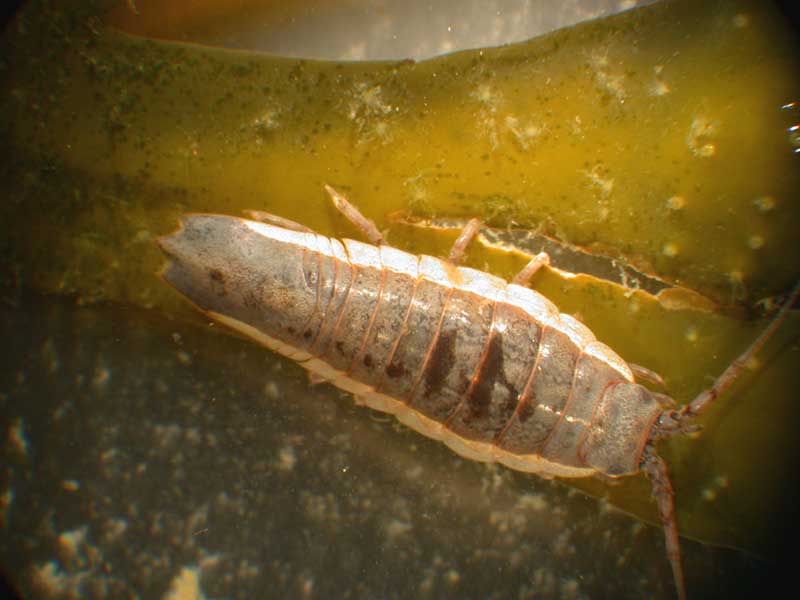Baltic isopod (Idotea balthica)
Distribution data supplied by the Ocean Biodiversity Information System (OBIS). To interrogate UK data visit the NBN Atlas.Map Help
| Researched by | Dr Harvey Tyler-Walters | Refereed by | This information is not refereed |
| Authority | (Pallas, 1772) | ||
| Other common names | - | Synonyms | - |
Summary
Description
A dorso-ventrally flattened isopod crustacean with an elongated oblong, oval body. The body is uniformly green or brown in colour, often with white spots or longitudinal lines. Females are often darker than males. Males range in length from 1-3 cm while females range from 1-1.8 cm. The distinct head bears two dorso-lateral eyes, a pair of short antennules, and a pair of antennae. Most of the body is taken up by a thorax composed on seven sections (somites). The body ends in a short abdomen (two somites) and a distinct tail-piece (the pleotelson). The pleotelson in adults is characteristic, with approximately straight sides, a dorsal keel, and a posterior edge bearing three processes, of which the middle one is the longest. The three processes develop with age and are absent in juveniles.
Recorded distribution in Britain and Ireland
Widely recorded from the Shetland Isles, Orkney and east Scotland, to the north-east, south, and south-west coasts of England, and the west coasts of Wales and Scotland. A few records from Ireland, although probably under-recorded.Global distribution
Widespread from northern Norway, the Gulfs of Bothnia and Finland, south to the Black Sea and along the north-west coast of North America.Habitat
A primarily subtidal species also found in the intertidal feeding on seaweeds but sometimes abundant amongst stranded seaweed on the drift-line.Depth range
Lower shore - 60 mIdentifying features
- A dorso-ventrally flattened and oblong, oval body.
- The abdomen (pleon) consists of two complete somites and one partial suture.
- The pleotelson bears three processes (tridentate).
- Antennule just or equal in length to the third section of the antenna.
- Antennal flagellum longer than its peduncle and about a quarter of the body length.
- The tops of the legs bear large coxal plates in the adult.
Additional information
-none-Listed by
- none -
Bibliography
Bruce, J.R., Colman, J.S. & Jones, N.S., 1963. Marine fauna of the Isle of Man. Liverpool: Liverpool University Press.
Hayward, P., Nelson-Smith, T. & Shields, C. 1996. Collins pocket guide. Sea shore of Britain and northern Europe. London: HarperCollins.
MBA (Marine Biological Association), 1957. Plymouth Marine Fauna. Plymouth: Marine Biological Association of the United Kingdom.
Naylor, E., 1972. British marine isopods. London: Academic Press. [Synopses of the British Fauna, no. 3.]
Datasets
Centre for Environmental Data and Recording, 2018. Ulster Museum Marine Surveys of Northern Ireland Coastal Waters. Occurrence dataset https://www.nmni.com/CEDaR/CEDaR-Centre-for-Environmental-Data-and-Recording.aspx accessed via NBNAtlas.org on 2018-09-25.
Environmental Records Information Centre North East, 2018. ERIC NE Combined dataset to 2017. Occurrence dataset: http://www.ericnortheast.org.ukl accessed via NBNAtlas.org on 2018-09-38
Fenwick, 2018. Aphotomarine. Occurrence dataset http://www.aphotomarine.com/index.html Accessed via NBNAtlas.org on 2018-10-01
Fife Nature Records Centre, 2018. St Andrews BioBlitz 2014. Occurrence dataset: https://doi.org/10.15468/erweal accessed via GBIF.org on 2018-09-27.
Fife Nature Records Centre, 2018. St Andrews BioBlitz 2016. Occurrence dataset: https://doi.org/10.15468/146yiz accessed via GBIF.org on 2018-09-27.
Kent Wildlife Trust, 2018. Kent Wildlife Trust Shoresearch Intertidal Survey 2004 onwards. Occurrence dataset: https://www.kentwildlifetrust.org.uk/ accessed via NBNAtlas.org on 2018-10-01.
Lancashire Environment Record Network, 2018. LERN Records. Occurrence dataset: https://doi.org/10.15468/esxc9a accessed via GBIF.org on 2018-10-01.
Manx Biological Recording Partnership, 2018. Isle of Man historical wildlife records 1990 to 1994. Occurrence dataset: https://doi.org/10.15468/aru16v accessed via GBIF.org on 2018-10-01.
Merseyside BioBank., 2018. Merseyside BioBank (unverified). Occurrence dataset: https://doi.org/10.15468/iou2ld accessed via GBIF.org on 2018-10-01.
National Trust, 2017. National Trust Species Records. Occurrence dataset: https://doi.org/10.15468/opc6g1 accessed via GBIF.org on 2018-10-01.
NBN (National Biodiversity Network) Atlas. Available from: https://www.nbnatlas.org.
OBIS (Ocean Biodiversity Information System), 2025. Global map of species distribution using gridded data. Available from: Ocean Biogeographic Information System. www.iobis.org. Accessed: 2025-07-30
South East Wales Biodiversity Records Centre, 2018. SEWBReC Myriapods, Isopods, and allied species (South East Wales). Occurrence dataset: https://doi.org/10.15468/rvxsqs accessed via GBIF.org on 2018-10-02.
Yorkshire Wildlife Trust, 2018. Yorkshire Wildlife Trust Shoresearch. Occurrence dataset: https://doi.org/10.15468/1nw3ch accessed via GBIF.org on 2018-10-02.
Citation
This review can be cited as:
Last Updated: 09/05/2005



